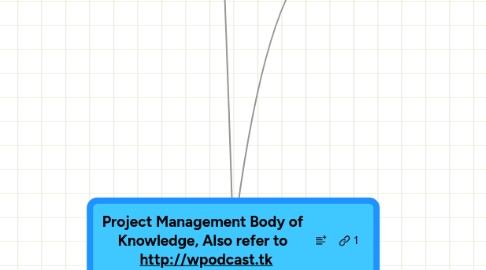
1. Five Project Management Process Groups
1.1. Initiating Process Group
1.1.1. develop project charter
1.1.2. develop preliminary project scope statement
1.2. Planning Process Group
1.2.1. develop project management plan
1.2.2. scope planning
1.2.3. scope definition
1.2.4. create WBS
1.2.5. activity planning
1.2.6. activity sequencing
1.2.7. activity definition
1.2.8. activity resource estimating
1.2.9. activity duration estimating
1.2.10. schedule development
1.2.11. cost estimating
1.2.12. cost budeting
1.2.13. quality planning
1.2.14. human resource planning
1.2.15. communication planning
1.2.16. risk management planning
1.2.17. risk identification
1.2.18. qualitative risk analysis
1.2.19. quantitative risk analysis
1.2.20. risk response planning
1.2.21. plan purchase and acquisition
1.2.22. plan contracting
1.3. Executing Process Group
1.3.1. acquire project team
1.3.2. develop project team
1.3.3. perform quality assurance
1.3.4. information distribution
1.3.5. request seller response
1.3.6. select sellers
1.3.7. direct and manage project execution
1.3.7.1. inputs
1.3.7.1.1. administrative closure procedure
1.4. Monitoring and Controlling Process Group
1.4.1. scope control
1.4.2. cost control
1.4.3. schedule control
1.4.4. quality control
1.4.5. manage stakeholders
1.4.6. manage project team
1.4.7. risk monitoring and control
1.4.8. contract administration
1.4.9. scope verification
1.4.10. performance reporting
1.4.11. monitor and control project work
1.4.12. integrated change control
1.5. Closing Process Group
1.5.1. close project
1.5.1.1. outputs
1.5.1.1.1. contract closure procedure
1.5.1.1.2. administrative closure procedure
1.5.2. contract closure
1.5.2.1. inputs
1.5.2.1.1. contract closure procedure
2. Nine Knowledge Areas
2.1. Project ScopeManagement
2.1.1. scope planning
2.1.2. scope definition
2.1.3. create WBS
2.1.4. scope verification
2.1.5. scope control
2.2. Project Time Management
2.2.1. activity definition
2.2.2. activity sequencing
2.2.3. activity resource estimating
2.2.4. activity duration estimating
2.2.5. schedule development
2.2.6. schedule control
2.3. Project Cost Management
2.3.1. cost estimating
2.3.2. cost budgeting
2.3.3. cost control
2.4. Project Quality Management
2.4.1. quality planning
2.4.2. perform quality assurance
2.4.3. quality control
2.5. Project Human Resource Management
2.5.1. human resource planning
2.5.2. acquire project team
2.5.3. develop project team
2.5.4. manage project team
2.6. Project Communications Management
2.6.1. communications planning
2.6.2. information distribution
2.6.3. manage stakeholders
2.6.4. performance reporting
2.7. Project Risk Management
2.7.1. risk management plannnig
2.7.2. risk identification
2.7.3. qualitative risk analysis
2.7.4. quantitative risk analysis
2.7.5. risk response planning
2.7.6. risk monitoring and control
2.8. Project Procurement Management
2.8.1. plan purchase and acquisition
2.8.2. plan contracting
2.8.3. request seller response
2.8.4. select sellers
2.8.5. contract administration
2.8.6. contract closure
2.8.6.1. inputs
2.8.6.1.1. contract closure procedure
2.9. 4 Project Integration Management
2.9.1. develop project charter
2.9.2. develop preliminary project scope statement
2.9.3. develop project management plan
2.9.4. direct and manage project execution
2.9.5. monitor and control project execution
2.9.6. integrated change control
2.9.7. close project
3. Project Life Cycle & Organization
3.1. phases
3.1.1. initial
3.1.1.1. high influence of stakeholders
3.1.2. intermediate
3.1.2.1. high influence of PM
3.1.3. final
3.1.3.1. low influence of stakeholders
3.1.3.2. phase-end review (phase exits/phase gates/kill points)
3.2. feasibility study
3.3. schedule compression technique
3.3.1. fast tracking
3.3.1.1. risks
3.3.2. crashing
3.3.2.1. costs
3.4. Project Stakeholders
3.4.1. positive
3.4.2. negative
3.5. organizational Influences
3.5.1. Culture
3.5.1.1. shared values
3.5.1.2. norms
3.5.1.3. beliefs
3.5.1.4. expectations
3.5.1.5. policies
3.5.1.6. procedures
3.5.1.7. view of authority relationships
3.5.1.8. work ethic and work hours
3.5.2. Style
3.5.3. Organizational Structure
3.5.3.1. functional
3.5.3.1.1. grouped by speciality
3.5.3.1.2. limited to the bouindaries of the function
3.5.3.2. weak matrix
3.5.3.2.1. PMO doesn't directly report to cheif executive
3.5.3.3. balanced matrix
3.5.3.3.1. functional manager and PM control the budget
3.5.3.4. strong matrix
3.5.3.4.1. full-time PM
3.5.3.4.2. full-time project administrative staff
3.5.3.4.3. PM controls the project bedget
3.5.3.4.4. Manager of project managers (if PMO exists)
3.5.3.5. projectized
3.5.3.5.1. PM has a great deal of independence and authority
3.5.3.5.2. provide support to the various projects
3.5.3.6. composite
3.5.3.6.1. projectized organization
3.5.3.6.2. Managers of project managers (if PMO exists)
3.5.4. PMO
3.5.4.1. administrative support to PM
3.5.4.2. advisory
3.5.4.3. recommendation of specific policies and procedures
3.5.4.4. authority
3.5.4.5. manage the project management system
3.5.5. Project Management System
3.5.5.1. Tools
3.5.5.2. Techniques
3.5.5.3. Methdologies
3.5.5.4. Resources
3.5.5.5. Procedures
3.5.5.6. formal
3.5.5.7. informal
3.5.5.8. guide a project to completion
3.5.5.9. control functions
